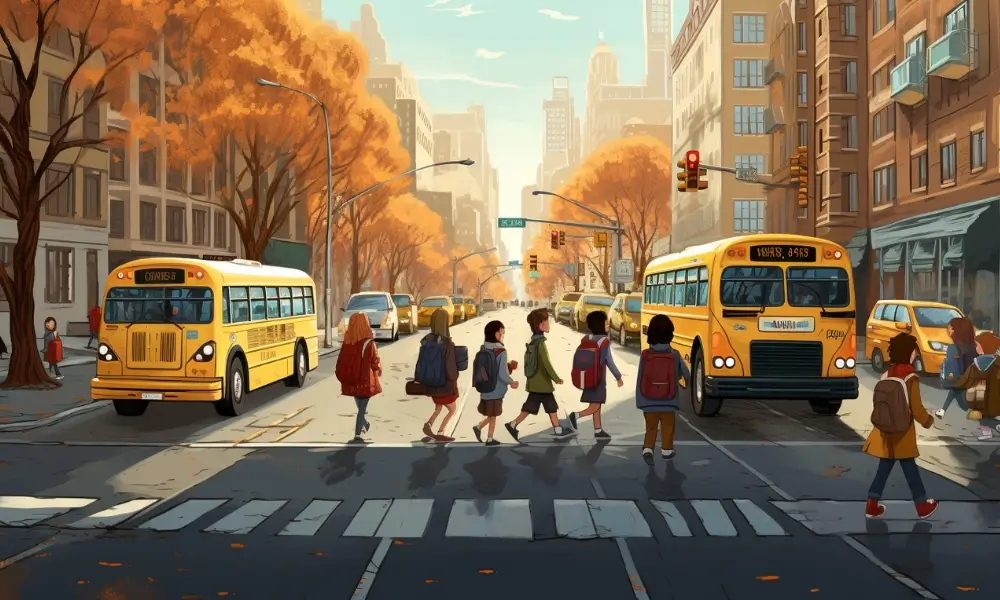As a parent, ensuring your child’s safety is always on your mind. While you may be comfortable trusting them to walk around a familiar neighbourhood, what happens when they need to travel alone or with friends on the road? Kids must be aware of and understand vital street smarts, such as obeying traffic signals and sidewalks and looking both ways before crossing an intersection.
These 13 rules for safely operating in roadway settings should be part of any conversation about keeping your children safe on their journeys. Allowing for open discussions about these points will help keep them physically and mentally focused on safe practices while travelling, thus building helpful self-regulating habits as they grow up.
Importance Of Road Safety Rules And Regulations For Kids
Keeping your kids safe at all times can be tricky when you cannot be with them always. Parents ensure the safety of their children at home, and teachers or caretakers are responsible for the kid’s safety at school. But who keeps them safe on the road?
Whether your children walk to school or take the bus, they should be taught the rules to stay safe on the roads. Understanding school safety signs, such as crosswalk signals and school zone speed limits, is crucial to help them make better decisions and avoid accidents.
“Safety First” is “Safety Always.” ~Charles M. Hayes
Unlike adults, children do not have the maturity to know what to do and what not when walking on the roads. Children can put themselves at risk without adult supervision and proper knowledge of road safety rules. According to a National Highway Traffic Safety Administration report for 2014, 3% of the people who died from road accidents were children. Statistics also show that 480 kids were injured daily due to road accidents in the same year. More disturbing is that of the 4,884 pedestrians killed in road accidents, 207 were kids.
When it comes to the safety of your children, you should not compromise. Teach about road safety for children as soon as they are old enough to step out of the house. Ensure that they understand what you are saying by practicing it with them.
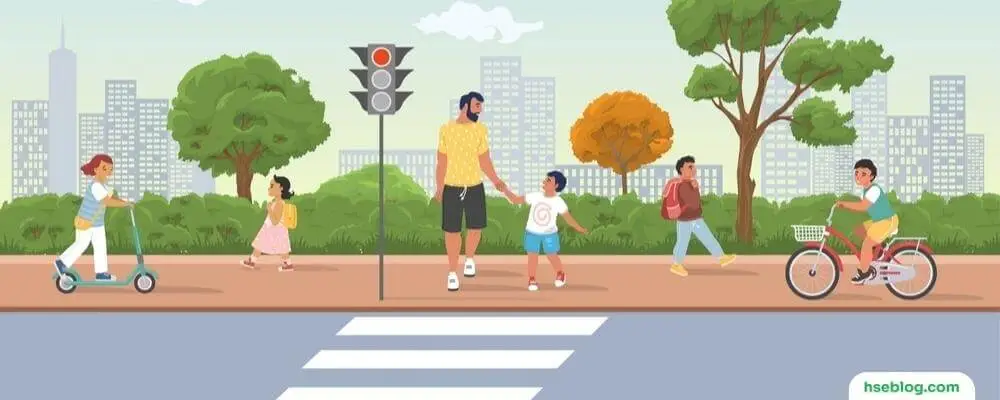
13 Rules To Ensure Road Safety For Kids
While it is essential for children to know about road safety rules and regulations, they should not be given more information than they can handle. Here are a few basic road safety rules for kids that you can begin with.
1. Know Your Signals

Help your kid learn about the traffic lights and signs and what each color indicates.
- Green means ‘go’: Vehicles move ahead only when the signal turns ‘green.’
- Red means to ‘stop’: When the signal turns red, all vehicles must stop.
- Yellow means to slow down: When the signal turns yellow, vehicles should slow down and prepare to stop.
- The ‘Walk’ or a walking man symbol at intersections is for pedestrians. Cross the road only if these signs turn green. But look to the left and right to ensure no vehicles are approaching.
- Never cross the road if the sign says ‘Don’t Walk’ or the walking man symbol turns red.
Sometimes, a hand symbol is used instead of the walking man or ‘Walk’ signals. Tell your kid about that, too. If there are other symbols for pedestrians, you should make it a point to let them know. Gradually, teach your children about the other essential traffic signals they should know.
2. Stop, Look, And Cross
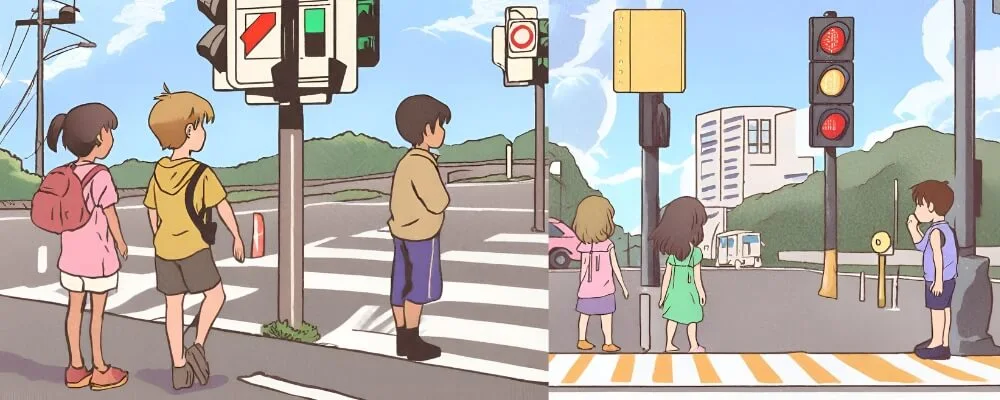
Your child may have to walk back to school or the bus stop. They may only have to cross the street after the school bus drops them off. Even if they don’t, they may have to cross the street to get to a friend’s house or a neighbor’s. Whatever the case is, you should teach your kids to cross the road safely. Here’s how you can help them learn.
Always look for signals and use the pedestrian crossing to cross the road. In the absence of such markings, here is what you should do:
- Look to your right and then to the left to see if there are any approaching vehicles.
- If yes, wait for the vehicle to pass and then cross the road.
- Never cross at bends.
- Never cross between stationary vehicles.
Adults should always accompany children under six and hold their hands when crossing the street.
3. Pay Attention – Listen

Teach your kids that they may not always be able to see an oncoming vehicle, especially if they are standing near a bend. Therefore, they should listen to know if a vehicle is approaching. Cars and other vehicles on the road often use the “horn” at bends and unmanned intersections to indicate that they are nearing. Tell your children:
- If they hear a horn, stop and look to the left and right to see if any vehicle is approaching.
- Listen for engine sounds nearby to know if there is a moving vehicle – explain how a loud noise indicates the vehicle is nearby, and a faint sound means it is away.
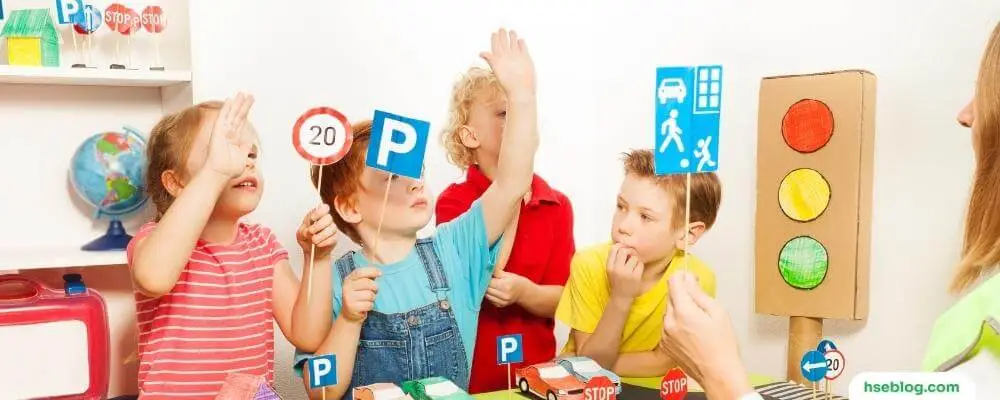
4. Don’t Run On Roads

Children may not always have patience and may run across the street to get to the other side. They may also run along the road in your neighborhood while playing. Tell your kids never to run across or along the road. Children can get distracted easily and leave their guardian’s hands to run or sprint away.
Teach your kids to stay calm on the road and never to run or sprint.
5. Always Use Sidewalks

Teach your kids to use the sidewalk when walking on the road. Set an example for them by using the walking paths yourself. Whether it is a busy street or not, encourage your kid to use the sidewalk to stay safe on the road.
6. Crossroads And Pedestrian Crossing
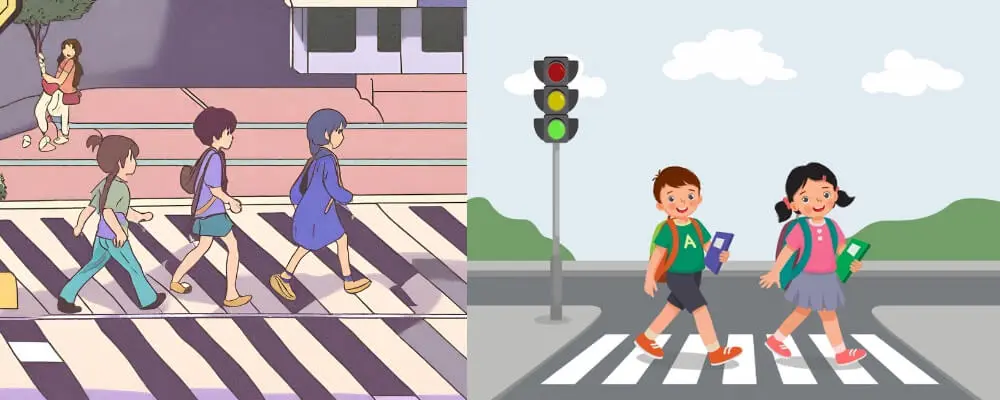
Kids tend to sprint across the street, anywhere they like. That can be dangerous as passing vehicles do not slow unless there is a signal or a crossroad. Tell your kids to cross only at an intersection and use the pedestrian crossing. If they are in a small neighborhood with no crossroad or marked crossing, they should follow the rules mentioned above.
Lessons on pedestrian safety for kids are important and should also be included in the school curriculum.
7. Never Stick Hands Outside The Vehicle

Kids tend to put their hands out of the school bus even when it is moving. Some may even put their head out to look back and wave. This is common with students taking the school bus. It may seem fun, but sticking hands or heads out of a moving vehicle can be highly dangerous. If children are not careful, they could be hit by vehicles approaching from the opposite direction.
8. Never Cross Road At Bends

Bends are the blind spots for motorists. When you cross at a bend, you do not give the vehicle drivers enough time to spot you and stop the car. Tell your kid never to cross at a bend, which can increase their chances of getting hurt.
9. Staying Safe On A Bicycle

If you have an older kid who rides his bike to school or around the neighborhood, make sure he is aware of and follows the following cycling rules to stay safe on the road.
- Always wear a helmet when riding a bike.
- Check if the bicycle is in working condition before using it – check for breaks and light if using it at night.
- Always use the bicycle lane. In its absence, ride the bike on the extreme right or left side (whichever is right in your country) of the road and move along with traffic. Keep your eyes and ears open to make way for more extensive and faster vehicles behind you.
- Always use light in areas with poor visibility and at night to be easily noticed by motorists.
- Do not allow kids to ride a cycle on busy streets without parental supervision.
10. Staying Safe Inside A Moving Vehicle

In a moving car, you can ensure your kid is safe with the help of a car seat or seat belt. To see that they are safe in a moving vehicle without you, make sure they learn and follow these simple rules:
- Never stand inside a moving vehicle, especially a school bus or van.
- Students should not move around inside a moving school bus.
- Stay seated and hold on to the hard rail inside the bus for support until the vehicle comes to a stop.
- Do not put any part of the body outside the window of a moving vehicle.
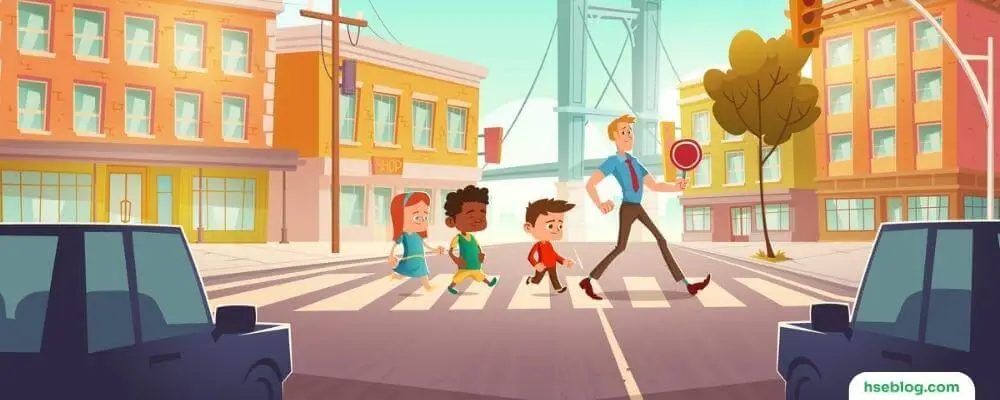
11. Always Get Out At The Curb Side

If your kid takes the school bus daily, help them remember these safety tips.
- Start early and be on time to avoid running for the bus.
- Always stand in the queue when boarding and alighting the bus.
- Always get off the curbside when getting off a car or the bus to prevent obstructing the other vehicles on the road.
12. Be Seen, Stay Safe

Dressing in black may be bad when you want to walk at night. Vehicle drivers must notice you if you want to stay safe. To be seen:
- Wear light-colored clothes or reflective material when walking or biking at night.
- Wear bright clothing during the day.
- Wave your hand to indicate your presence to an oncoming vehicle.
13. Don’t Rush

Children can get excited and rush to get to a place or meet someone. That can be dangerous. Teach your kids:
- Do not rush when getting into or off a vehicle, as it can be hazardous.
- Do not get distracted or suddenly drag the parent or guardian in a particular direction, as this can throw the adult off guard.
- Stay calm and do not rush when walking on the street.
- Do not open the car doors suddenly; they then get into the habit of opening them only after you say so.
- Do not play in the bus bay or on the roads.
Conclusion
Instilling road safety awareness in children is essential in order to safeguard their lives and well-being. By teaching them the 13 rules outlined in this blog post, parents and guardians can empower their kids to navigate the streets responsibly and confidently. While it’s important to focus on practical skills, like crossing the street safely and understanding traffic signals, it’s equally vital to emphasize the importance of good habits, such as being attentive, wearing the appropriate gear, and respecting other road users.
Ultimately, road safety for kids is a collective responsibility that extends beyond parents and children to the entire community. As adults, let’s strive to be responsible drivers, pedestrians, and role models for the younger generation. By working together, we can create a safer environment on the roads for everyone and ensure our children grow up with the knowledge and skills to protect themselves and others in their daily lives.

